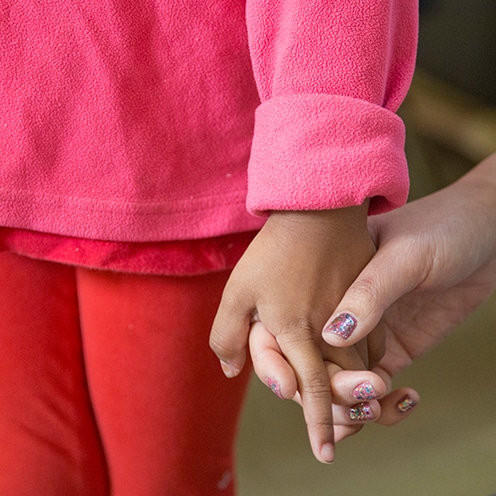
How Educators Can Address Trauma During the Pandemic
A mental health professional on trauma and ways teachers can address it with their students and in their own lives.
Being an educator normally comes with its own set of stressors and anxieties. But in the midst of the COVID-19 pandemic, students and teachers may be experiencing traumatic situations.
We spoke with clinical psychologist Dr. Richard Shadick, who is Teach For America’s national mental health consultant, to gain insight into how teachers can approach students affected by trauma, and manage it in their day-to-day.
First off, would you mind providing a definition of what trauma is?
There are a lot of different definitions of trauma but the one I find most useful is from the American Psychological Association—”trauma is an emotional response to a terrible (and potentially life-threatening) event like an accident, rape or natural disaster. Immediately after the event, shock and denial are typical. Longer term reactions include unpredictable emotions, flashbacks, strained relationships and even physical symptoms like headaches or nausea.”
As a teacher, how do you connect with a student who may be experiencing trauma?
The best way to connect with a student is starting one-on-one. Traumatized students may struggle with their emotions at such a high level that it's hard for them to manage their feelings and focus on their studies. They need some individual support to be able to engage in classroom learning. I am in no way advocating that teachers should take the role of a therapist. Rather, I am suggesting a teacher be a facilitator for help. A teacher can identify the issues at hand, bring in others, such as parents, caregivers, or administrators so that they can support the student.
It's essential to address the student’s emotional well being and the reasons why these trauma symptoms are surfacing. Teachers should have a one-on-one discussion to learn what's going on at home, at school, and in the community, and use the principles of social-emotional learning in the conversation. In doing so, students are more likely to be responsive in class, and their academics may improve. For example, a teacher may notice that a student is nervous and distracted after a traumatic event. A teacher may say, “I notice you have been having difficulty focusing in class since the event. Maybe we can find some ways to address your feelings so you can focus again? Can you describe what you feel by using some feeling words? How do those feelings make it hard to pay attention in class?”
When you talk about trauma symptoms with students, what are some of those symptoms?
It is common to mistake trauma symptoms for hyperactivity, as some of the symptoms are similar. In the classroom, teachers might see behaviors like hypervigilance, fidgeting, difficulty concentrating, irritability, repetitive thematic play around a traumatic event, somatic symptoms, regressive behavior, or passivity.
You mentioned social-emotional learning, can you touch on that some?
Unfortunately, for many kids, it can be challenging to label, understand, and regulate emotions. Kids don't often have the opportunity to learn these skills, so any classroom teaching should focus on the basics of social-emotional learning, such as recognizing, understanding, labeling, expressing, and regulating their emotions. The Yale Center for Emotional Intelligence uses the RULER rubric to help students manage their feelings so they can be better learners; there are a number of different approaches to social-emotional learning that are equally effective. In learning about feelings and relationships, students become able to downregulate their emotions and clear the way for learning. Many schools and districts have Social Emotional Learning curriculum that teachers can leverage. If you don’t, you can find more resources on Teach For America’s Curriculum Finder.
How does an educator go about approaching a student who is dealing with trauma?
First, it is important to find a time and place to give your student your undivided attention. Next, talk with them about what is surfacing. You might want to say, "I see it's hard for you to concentrate in the last couple days. Can you tell me what's happening?" and allow them to share what might be preoccupying or distracting them.
It is important to mention that a holistic approach to addressing trauma is key. Intervention should not just be in the classroom. An effective approach to dealing with trauma requires a change in school policies and culture. All faculty and administrators, as well as the community, are essential to address the needs of children.
Is there anything an educator should avoid when approaching a student who may be experiencing trauma?
Teachers should avoid stressful challenges or activating language that describes traumatizing events in detailed terms. Teachers should also try not to discipline behaviors such as inattention that are due to the trauma.
When it comes to a teacher who's experiencing trauma, what are some of the things they can do for themselves?
Vicarious trauma is a significant issue for teachers, too. Being exposed to traumatic situations from multiple students can lead teachers to feel very overwhelmed and develop some of the same symptoms as their students.
Vicarious trauma can be addressed in a manner similar to burnout—making a clear line between work and personal life, and taking steps to incorporate self-care such as exercising daily, eating right, and sleeping enough. It's also essential to avoid triggers that are activating, such as the news, and to access support systems, whether it be a house of worship or a therapist.
We spoke earlier about the symptoms a student dealing with trauma might experience, what about a teacher?
Vicarious traumatization, or experiencing the trauma that one has been exposed to from others is similar to student trauma. A teacher may experience hypervigilance or edginess, they may have repetitive bad dreams, or they may find themselves avoiding situations connected with the trauma. It may make it hard for the teacher to work or connect with others in their lives.
You spoke about compassion fatigue, could you explain more about that?
There are three entities that mental health clinicians often think about in this area. There's burnout, vicarious trauma, and compassion fatigue. A classic example of compassion fatigue is a nurse who works day in and day out with patients and starts to lose their ability to connect with their patients as humans.
Teachers sometimes can lose their ability to connect with a student in a compassionate way or may not have as much empathy for their struggles. They tend to become numb emotionally and lose their effectiveness as educators.
What are some trauma resources that educators can look to?
One of my favorite resources that I often refer teachers to is the National Child Traumatic Stress Network. They have a large number of resources for administrators, teachers, families, and clinicians. Also Edutopia has a webpage of trauma-related resources for educators too.
Often, I think burnout and vicarious trauma surface because teachers have difficulty making clear boundaries between work and home. Their workday doesn't end at 3 or 5 p.m.; they work well into the evening, and they're making phone calls and completing lesson planning on the weekend. Teachers are some of the hardest working professionals I know. It is important for them to have good boundaries, to separate work from leisure, and to be involved in other kinds of activities that are non-work related to help them reset their stress levels. Anything that is healthy and stress-relieving can help-yoga, meditation, exercise trackers like Fitbits are all good tools.
Looking for more COVID-related support? From online teaching support to curriculum and school management resources, you can find guidance on how to support students and communities during the coronavirus outbreak on TFA's COVID-19 Education Resource Hub.
Sign up to receive articles like this in your inbox!
Thanks for signing up!
Content is loading...






